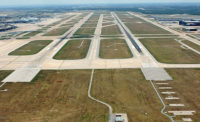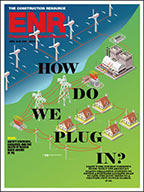Getting Connected
The team's iPad strategy has evolved since the concept was first tested in January 2011. Initially, the team hoped that users would be able to access documents placed on a cloud server while in the field, allowing real-time access. However, connectivity proved difficult.
"We love to believe that in this world of technology, you'd get perfect connectivity, but that's not reality," Pistor says. "Even when you get good connectivity, it could take at least a minute to bring up a document from the Web. Do you know what the half-life of an iPad is in the hands of an anxious superintendent who has to wait a minute per document? It wouldn't last long."
Instead, the team developed a system that syncs to a cloud server, allowing team members to download the most up-to-date versions of drawings to their iPads. Pistor estimates that even large documents take less than 10 seconds to load when they are stored directly on an iPad. To execute this system, team members use the GoodReader app on iPads to view PDF documents, which are centrally stored on Ignite Cloud Storage. Bringardner says the team was able to sync both systems without any customization. When a user brings up a document, GoodReader automatically searches for the most up-to-date version.
Pistor says he recommends that team members sync their iPads every night, so that they have up-to-date information to take into the field the next day.
Still, users have remote access on site. Bringardner says people can access the cloud throughout most of the jobsite. DFW has expanded WiFi access for the crew, including new portable antennae that can be added to locations that might not otherwise have access, such as a tunnel or a roof. Bringardner says WiFi is primarily used for immediate communications, such as e-mail or critical requests for information. "People can take a picture of an issue with the iPad, mark it up and shoot it back to the trailer," he says.
Safe and secure
Access and user permissions were a significant focus of the implementation team. The server is broken into a series of folders to help keep files organized. Each user can set up his or her own folders to have access to information that is of specific relevance. For example, code checkers could have code books ready to download from their folders.
There is both one-way and two-way access options. Everyone gets access to the record drawings, but only certain users have permission to alter documents.
A field superintendent who wants to issue a request for information (RFI) can mark it up in GoodReader and put it in a folder. The project engineer then accesses that information and puts the RFI into the project management software, Constructware. If changes to documents are made, new PDFs are created and distributed out to the team through the server.








